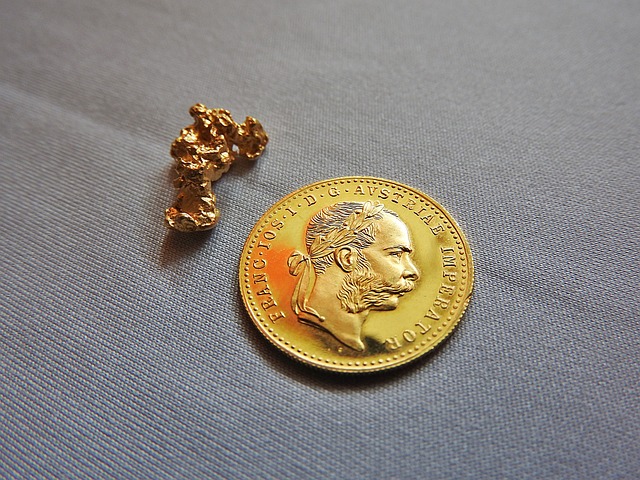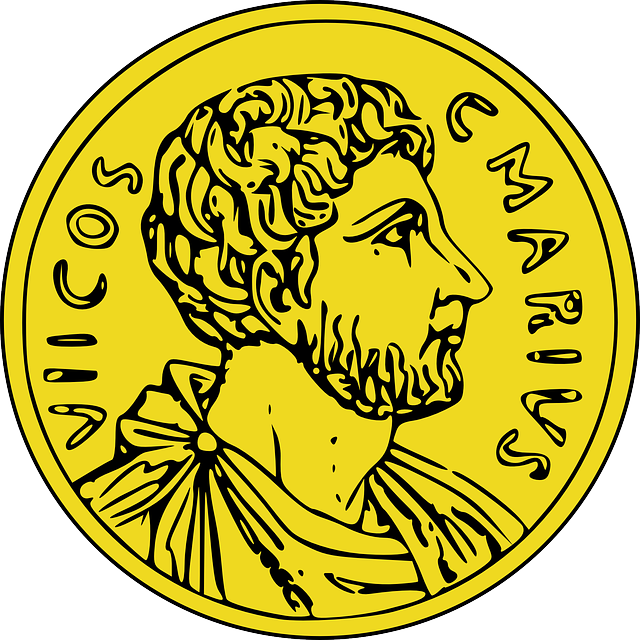When considering a Gold IRA versus gold ETFs for retirement investment, it's crucial to evaluate how each affects portfolio diversification and risk management. A Gold IRA allows for direct ownership of physical gold, silver, platinum, and palladium within a tax-advantaged framework, offering a tangible asset that can hedge against inflation and market instability. In contrast, gold ETFs provide indirect exposure to gold with liquidity but involve higher management fees and are subject to trading volumes and sentiment. Both options should be assessed based on cost, including storage and maintenance fees for physical gold, custodial services, and potential capital gains tax implications. Investors should consider their risk tolerance, liquidity preferences, and long-term financial goals when deciding between these two types of investments as part of a comprehensive retirement strategy that may benefit from the addition of precious metals to mitigate economic uncertainties. The decision between a Gold IRA and gold ETFs should be informed by a thorough analysis of personal investment needs and the desired role of gold in a diversified portfolio for secure financial stability in retirement.
Navigating retirement planning can be a complex endeavor, with diverse investment options available. Among these, Gold IRAs stand out as a tangible asset that can offer both stability and growth potential. This article delves into the intricacies of Gold IRAs, contrasting them with Gold ETFs, to help you determine which investment vehicle aligns with your retirement security goals. We will spotlight the top Gold IRA companies in the industry, providing an in-depth overview of their services and offerings. Understanding the factors that distinguish these companies is crucial for making informed decisions. Additionally, we’ll explore how incorporating precious metals can diversify and enhance your retirement portfolio, offering strategies to seamlessly integrate Gold IRAs into your long-term investment plan.
- Understanding Gold IRAs: A Guide for Retirement Planning
- Gold IRA vs. Gold ETFs: Comparing Investment Vehicles for Retirement Security
- Top Gold IRA Companies: An Overview of Leading Providers in the Industry
- Evaluating Factors: What to Look for in a Gold IRA Company
- The Role of Precious Metals in Diversifying Your Retirement Portfolio
- Strategies for Incorporating Gold IRAs into Your Long-Term Investment Plan
Understanding Gold IRAs: A Guide for Retirement Planning

When considering a Gold IRA for retirement planning, it’s crucial to understand how it compares with other investment vehicles such as gold ETFs (Exchange-Traded Funds). A Gold IRA allows individuals to diversify their retirement portfolio by including physical gold, silver, platinum, and palladium within a tax-advantaged account. Unlike gold ETFs that track the price of gold, a Gold IRA holds actual precious metals. This distinction is significant because while gold ETFs can be subject to market fluctuations and trading fees, the value of physical gold in an IRA may offer a hedge against inflation and market volatility.
Investors should evaluate factors such as storage, liquidity, and management when comparing Gold IRAs to gold ETFs. Physical gold requires secure storage, which can be provided by the Gold IRA custodian or a third-party depository. In contrast, gold ETFs are traded on exchanges like regular stocks, offering high liquidity but with the intangible risk that comes with paper assets. The choice between a Gold IRA and gold ETFs hinges on individual investment goals, risk tolerance, and the desired level of control over the investment. Both options have their place in a diversified retirement portfolio, and understanding the nuances of each is essential for informed decision-making within the realm of retirement planning.
Gold IRA vs. Gold ETFs: Comparing Investment Vehicles for Retirement Security

When considering retirement security, investors often ponder between Gold IRAs and Gold ETFs as valuable components of a diversified portfolio. A Gold IRA allows individuals to defer taxes on traditional accounts by investing in physical gold, silver, platinum, and palladium, offering a tangible asset that has historically maintained its value over time. This type of investment vehicle can provide a hedge against inflation and currency devaluation, ensuring wealth preservation alongside growth potential. On the other hand, Gold ETFs, such as SPDR Gold Shares (GLD), offer exposure to gold prices without the need to physically hold the metal. They are traded on major exchanges during regular market hours and can be a more liquid investment compared to a Gold IRA, which is subject to the volatility of the precious metals market and the custodial requirements set forth by IRS regulations.
Investors must weigh the benefits and limitations of each when deciding between a Gold IRA and Gold ETFs for their retirement portfolio. Gold IRAs provide direct ownership of the bullion or coins, which can be attractive for those who prefer the security of owning the actual commodity. However, this comes with additional responsibilities in terms of storage and insurance. Gold ETFs, by contrast, offer convenience, lower costs, and the ability to invest with a smaller capital outlay, as they are shares in a trust that tracks the price of gold. Both investment vehicles have their roles; a Gold IRA can serve as a long-term store of value, while Gold ETFs may be more suited for short-term trades or as part of a broader market investment strategy. Ultimately, the choice between a Gold IRA and Gold ETFs should align with one’s retirement goals, risk tolerance, and investment horizon.
Top Gold IRA Companies: An Overview of Leading Providers in the Industry

When considering a diversified retirement portfolio, investors often weigh the benefits of a Gold IRA against those of ETFs. A Gold IRA can provide a tangible asset to hedge against inflation and market volatility, offering a physical stake in precious metals like gold, silver, platinum, and palladium. This contrasts with Gold ETFs, which track the price of gold without holding actual bullion or coins. Among the top Gold IRA companies that stand out in the industry are firms renowned for their robust services, competitive pricing, and secure storage solutions. These leaders offer investors a chance to allocate a portion of their retirement savings into precious metals, potentially balancing their investment portfolio with a non-correlated asset. They provide personalized guidance to help clients navigate the process of rolling over existing retirement accounts into a Gold IRA, ensuring compliance with IRS regulations. With a focus on customer education and transparency, these companies make it easier for individuals to make informed decisions between a Gold IRA and ETFs based on their financial goals and risk tolerance. Whether investors are looking to diversify their investment or safeguard their wealth against economic uncertainties, the leading Gold IRA companies offer a range of services to accommodate various needs and preferences within the retirement planning space.
Evaluating Factors: What to Look for in a Gold IRA Company

When considering a Gold IRA for retirement, it’s crucial to evaluate various factors that distinguish reputable companies from less reliable ones. Among the key aspects to scrutinize are the company’s track record, customer service reputation, and the range of precious metals available within your IRA. Compare the costs associated with gold IRAs versus ETFs, as this can significantly impact your investment strategy. For instance, while gold ETFs offer exposure to gold prices without direct ownership of physical gold, they may come with higher management fees compared to a Gold IRA where you own the actual precious metals. Consider the storage options and associated fees for these metals; some companies provide their own secure storage facilities, which can add an additional layer of security and convenience. Additionally, assess the company’s history in facilitating self-directed IRAs, as well as their compliance with IRS regulations. This due diligence will ensure that your investment aligns with your retirement goals and provides the necessary diversification within your portfolio. It’s also prudent to review client testimonials and check for any history of legal or disciplinary actions against the company. By carefully considering these factors, investors can make an informed decision between a Gold IRA and ETFs, tailoring their choice to their individual retirement planning needs.
The Role of Precious Metals in Diversifying Your Retirement Portfolio

Incorporating precious metals into a retirement portfolio can serve as a strategic diversification tool, offering a hedge against inflation and market volatility. A Gold IRA, or Individual Retirement Account, allows investors to allocate a portion of their retirement savings to physical gold, gold bullion coins, and gold bars, providing a tangible asset that can potentially preserve wealth. This is particularly valuable in the context of economic uncertainty, as gold has historically maintained its value over centuries. Comparing a Gold IRA to ETFs or Exchange-Traded Funds, while ETFs offer exposure to gold prices through a more liquid and accessible investment vehicle, they do not provide the same level of tangible asset security. ETFs are dependent on the underlying assets’ performance in the market, which can be influenced by various factors such as trading volumes and market sentiment. On the other hand, physical gold held in an IRA is less susceptible to these market dynamics, offering a stability that can complement other investment types within a diversified portfolio. Investors considering a Gold IRA versus ETFs should evaluate their risk tolerance, liquidity needs, and long-term financial goals to determine the most suitable option for their retirement planning. Precious metals like gold can act as a counterbalance to paper assets, potentially reducing overall portfolio risk and providing a more secure financial footing for retirees.
Strategies for Incorporating Gold IRAs into Your Long-Term Investment Plan

When considering long-term investment plans, incorporating a Gold IRA can be a strategic move to diversify your retirement portfolio and potentially hedge against inflation and market volatility. Unlike traditional IRAs that invest in stocks, bonds, or mutual funds, a Gold IRA allows for the direct ownership of gold bullion, coins, or bars within a self-directed individual retirement account (IRA). This tangible asset can offer a counterbalance to paper assets, as gold has historically maintained its value over time.
Before integrating a Gold IRA into your investment strategy, it’s crucial to compare it with other precious metals investments, such as gold ETFs (Exchange-Traded Funds). Gold ETFs provide exposure to gold prices without the need to physically hold the metal. They can be more accessible and liquid than a Gold Iira, but they still come with their own set of risks and considerations. Investors should evaluate factors like annual fees, storage options, and the potential for capital appreciation when deciding between a Gold IRA and gold ETFs. For those committed to physical gold as part of a diversified retirement strategy, a Gold IRA can be an effective tool. It’s important to conduct thorough research, understand the custodial requirements, and consider the long-term implications of adding precious metals to your investment plan. This due diligence ensures that your Gold IRA complements your overall financial strategy for retirement security.
When considering a Gold IRA as part of your retirement strategy, it’s crucial to explore the leading companies that specialize in these investment vehicles. This article has provided a comprehensive overview, from understanding what a Gold IRA entails to comparing it with Gold ETFs. By examining top Gold IRA companies and the factors that distinguish them, you can make an informed decision tailored to your retirement planning needs. Gold IRAs serve as a valuable component in diversifying your portfolio, potentially enhancing your financial security during your golden years. As you weigh your options between physical gold and gold-backed ETFs, remember that the best choice aligns with your investment goals, risk tolerance, and long-term strategy. With the right guidance and a prudent approach to selecting a Gold IRA company, you can confidently navigate the path to a secure retirement.
